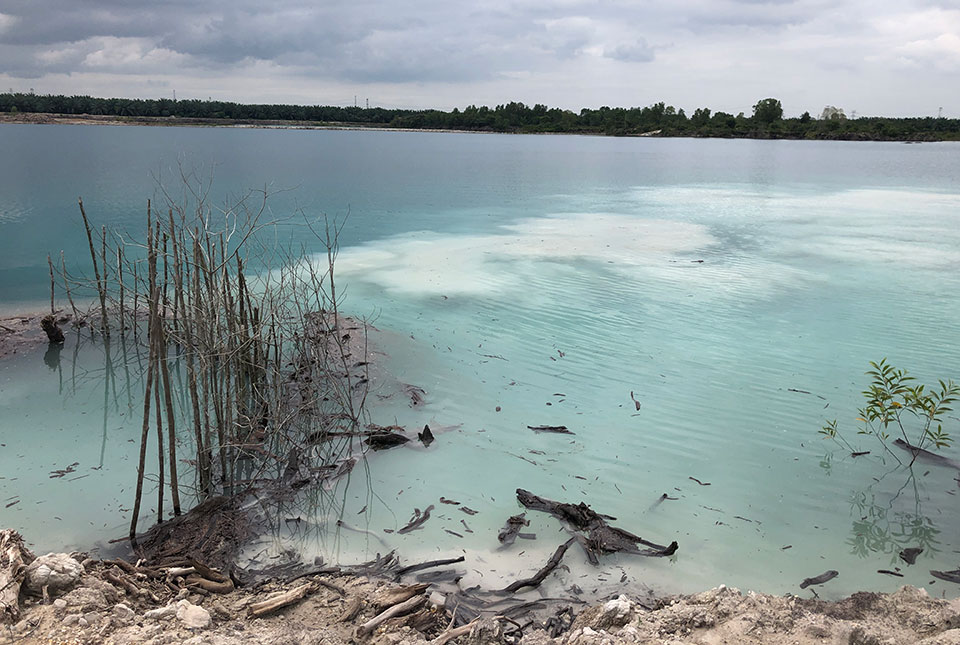Living in a world made of sand
Tom Bide and Clive Mitchell outline the BGS Sand and Sustainability project, which is working on geoscience-led solutions for the global issue of sand mining.
17/07/2023
What springs to mind when you think about sand? More than likely you’ll picture yourself on a beach building sandcastles and leaving footprints in the sand on the way to the sea.
Sand isn’t currently featured in the news like critical and battery minerals, which are so important for creating our cars and electronics. However, it is one of the most important industrial raw materials on the planet and is the second most utilised resource on Earth, after water. This is due to its use in the dominant construction material of the modern world, concrete.


How do we extract sand?
Sand is a high-bulk, low-value commodity and is usually mined close to where it is needed. In the UK, it generally does not travel far — around 30 to 40 km by road on average. Not all sand is suitable for construction: it must meet specific technical requirements for size, shape and composition of the sand grains. For example, although there is a lot of sand in deserts, it is generally not suitable for construction.

Sand mining. BGS © UKRI.
The ever-increasing global population and mass migration to cities has led to rapid, ongoing urban growth, particularly in the developing world. This in turn has accelerated the demand for concrete and construction raw materials such as sand, as people’s standard of living and need for decent housing and infrastructure increase. In many parts of the world, this demand has led to extensive, unregulated and illegal sand mining in delicate and environmentally sensitive environments, such as rivers and beaches. This unregulated mining can cause problems such as:
- erosion
- damage to infrastructure
- increased flood risk
- habitat loss
- pollution
- soil degradation
- destruction of farmland
The unsustainable demand can also affect economic growth due to material shortages, demand spikes, rapid price fluctuations and delays to major construction projects.
As sand mining is often small-scale, informal and localised, there is little information on where sand is mined, how much is produced or where it is consumed. This lack of understanding and data is a significant global problem highlighted by the United Nations Environment Programme (UNEP).
Are we running out of sand?
The answer is not straightforward. We live on a big planet that is full of sand. We are not going to run out of it, but sand does not always occur in the places where it is needed. The goal is to find sand resources on a local level that can be extracted sustainably, with the minimum environmental impact, whilst still meeting local economic needs. This way we can continue to build with sand and protect the environment for future generations.
How is BGS involved?
BGS has plenty of experience in monitoring, planning and managing sand resources in the UK. We work on geoscience-led solutions such as mapping resources and mines, understanding what makes a ‘good’ sand and looking into alternatives.
Keen to see how BGS could help in developing geoscience practices to solve the problems caused by the mismanagement of sand resources, a BGS team (Tom Bide, Alessandro Novellino and Clive Mitchell) recently visited Malaysia to meet with scientists, activists and the local industry as part of the BGS International Geoscience Research and Development (IGRD) programme.
We embarked on a non-stop tour of visits and meetings hosted by JMG (the Malaysian geological survey) and the helpful local representatives of the UK Science Innovation Network, hosted by the British High Commission in Kuala Lumpur. By talking to local quarrying companies, trade bodies, non-governmental organisations such as Friends of the Earth and academics from universities around Kuala Lumpur, we were able to really understand local issues. We saw examples of good practices to help us understand what does and doesn’t work on the ground in terms of resource management.

BGS visit to the British High Commission, Kuala Lumpur. BGS © UKRI
After two weeks in Malaysia dodging torrential downpours, being wowed by glittering skyscrapers and overindulging in the local cuisine, we attempted to create a few easily accessible resources using the good practice ideas we had learnt. We could then use them to promote better resource management in a range of countries where unsustainable sand mining is an issue.

Clive Mitchell and Tom Bide learning local best practice in Malaysia. © KUMPULAN SEMESTA SDN. BHD
In our next blog, we’ll discuss our findings and more information on the sustainable use of sand, as well as our new sand resources.
About the authors

Clive Mitchell
Industrial minerals geologist

Tom Bide
Minerals geoscientist


